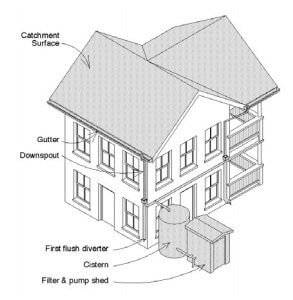 Rainwater collection is not new. Ancient Mayans did it. Early Texas settlers did it. It’s as old as civilization itself, and still works well today.
Rainwater collection is not new. Ancient Mayans did it. Early Texas settlers did it. It’s as old as civilization itself, and still works well today.
Many people are skeptical about relying solely upon rainwater for their home water use, but that’s only because they don’t realize how much water is falling on their roof every month. A good rule of thumb is that a half inch of rain will yield 300 gallons of water for every 1,000 square feet of roof.
Rainfall Water Capacity
In Austin, Texas, we get an average of 34 inches of rain each year. July is usually the driest month of the year in Austin with 1.86 inches of rain. Just an average 1,360-square-foot roof would yield 1,518 gallons of water in the driest month of the year. In Austin’s wettest month, that same roof would yield 3,508 gallons of water. So the average Austin roof receives a whopping 27,744 gallons of rainwater in an average year. Supply is not the problem, but capture and collection require capacity.
Sixty percent of an average American home in a city or suburb uses 60% of its water on the landscape.
What Do You Need to Harvest Rainwater?
 Gutters and a Downspout
Gutters and a Downspout
If you don’t already have rain gutters on your house, this one-time investment is the biggest cost you’ll face. High-quality gutters can be rather expensive, but even the least-expensive gutter system will suffice. A Downspout Diverter makes it easy to direct rainwater right into your storage tank.
Downspout Diverter
With a downspout diverter, you can send water right to your cistern or rain barrel. Automatic overflow control redirects water back to the downspout when the barrel is full.
Storage Tanks or Rain Barrels
Rainwater cisterns are necessary to get through the dry season in Texas. Cisterns are usually made of plastic or concrete, they can hold hundreds or even thousands of gallons of water. If you want to start small and keep it simple, consider a wood or plastic rain barrel, which will often hold from 40 to 80 gallons of water. If you have the space, several barrels can be lined up in tandem.
Debris Screen and Lid
Before the water goes into your cistern or rain barrel, you’ll want to use some kind of debris screen to filter out leaves, pine needles, and other debris. If you don’t, it will settle at the bottom of the tank and eventually clog up the outflow. A removable wire mesh screen is all you really need, either mounted on top of the rain barrel or attached to the end of your downspout. A well-fitting lid is also important to protect children and prevent mosquitoes from breeding in the water. Another option is Mosquito Control Rings.
 Distribution System
Distribution System
For a rain barrel, you need nothing more than a standard spigot or short length of hose installed near the bottom of the barrel, with an on/off valve. Then you let gravity do the work. You can attach a longer hose to reach your garden, or just use the spigot to fill watering cans. If you have a very large cistern, or want to distribute water some distance away, you will need a small pump.
Filtration and Disinfection
Many people use all their collected rainwater for irrigation, but more and more Texans are replacing their well or city water supply with rainwater. While Texas rainwater itself is very pure, the collection process may include debris, algae, chemicals, or even fecal matter from the roof or drainpipes. Mesh screens are the first step, keeping large pieces of debris from entering the tank. Water filters of increasing fineness, a carbon filter. and a UV light are commonly used to make the water safe for drinking and bathing. The UV light is able to kill any microorganisms left after filtration.
Resources
The Texas Water Development Board has published a thorough study on rainwater collection in Texas called The Texas Manual on Rainwater Harvesting.
The American Rainwater Catchment Systems Association is a 501(c)(3) non-profit organization that was founded in 1994 in Austin, Texas, to promote rainwater catchment systems in the United States.
Discuss the Rainwater Revival offers a fun day of activities, music, entertainment, and education about rainwater collection.
Rainwater vessels come in many different colors, shapes and styles and can actually blend in quite nicely with your home. Hayneedle offers many fashionable and practical styles.
Another good store for rainwater supplies is Tank Town on 2770 W Highway 290 in Dripping Springs ·(512) 894-0861.
